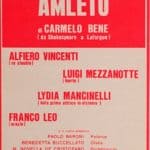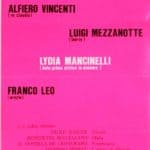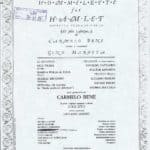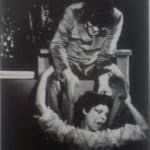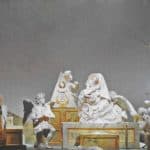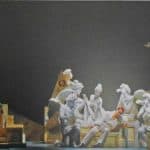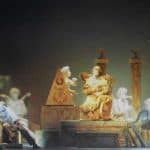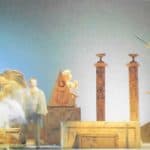This section is devoted to the story of “rewrite” that Carmelo Bene has accomplished from Shakespeare’s Hamlet between 1962 and 1994. Thirty years of activity and seven rewritings:: with actors, scripts, acting styles and different directional ideas. Between continuity and discontinuity, this path allows us to enter the creative laboratory of an actor-author such as Bene, exploding the concept of the show and inserting his work into the historical perspective of a continuous work around some great macro-texts.
Amleto (1962)
from Shakespeare
directed by Carmelo Bene
scenes, costumes and music by Carmelo Bene
with Carmelo Bene (Amleto), Stefano Carletti (Orazio), Luigi Mezzanotte (Rosencrantz o Guildenstern e Marcello),
Manlio Nevastri (Polonio), Giacomo Ricci (Laerte), Rosabianca Scerrino (Ofelia),Corrado Sonni (re Claudio), Igea Sonni (Gertrude)
Preview Rome, Teatro Laboratorio, October 20th
Amleto (1964)
from Shakespeare
directed by Carmelo Bene
scenes, costumes and music by Carmelo Bene
with Carmelo Bene (Amleto), Lydia Mancinelli (Gertrude), Luigi Mezzanotte (re Claudio), Manlio Nevastri (Polonio), Manuela Kustermann (Ofelia)
Preview Spoleto, Tendone presso lo stadio, July
Amleto. Basta con un “vi amo” mi ero quasi promesso. Amleto o le conseguenze della pietà filiale (1965)
from and by W. Shakespeare a Jules Laforgue
director, scenes, costumes and music by Carmelo Bene with the collaboration of Salvatore Siniscalchi
with Carmelo Bene (Amleto), Alfiero Vincenti (re Claudio), Lydia Mancinelli (Gertrude), Manlio Nevastri (Polonio), Manuela Kustermann (Ofelia), Ornella Ferrari (Kate), Michele Francis (Laerte), Enrico Boido (primo attore in Elsinore)
Preview Roma, Teatro Arlecchino, April 6
Amleto o le conseguenze della pietà filiale da LaforgueE (1967)
from Laforgue according to Carmelo Bene
director and music of Carmelo Bene
scenes of Tonino Caputo
costumes of Carmelo Bene, realization of Osvaldo Testa
with Carmelo Bene (Amleto), Lydia Mancinelli (Gertrude), Luigi Mezzanotte (Laerte), Carla Tatò (Kate), Margherita Puratich (Ofelia), Michele Francis (re Claudio), Adriano Bocchetta (Fortebraccio), Pietro Napolitano (Guildenstern), Pino Prete (Rosencrantz), Andrea Moroni (Orazio), Edoardo Florio (primo attore in Elsinore), Manlio Nevastri (Polonio)
Preview Rome, Beat 72, March 20
Amleto di Carmelo Bene (da Shakespeare a Laforgue) (1975)
directed by Carmelo Bene
scenes, costumes and music by Carmelo Bene
with Carmelo Bene (Amleto), Alfiero Vincenti (re Claudio), Luigi Mezzanotte (Laerte), Lydia Mancinelli (Kate), Franco Leo (Orazio), Paolo Baroni (Polonio), Benedetta Buccellato, (Ofelia), M. Novella De Cristofaro (Fortebraccio), Massimo Fedele (primo attore in Elsinore), M. Agnes Nobecourt (Gertrude), M. Luisa Serena (secondo attore in Elsinore), Marina Tagliaferri (Rosencrantz), Vera Venturini (Guildenstern)
Preview Prato, Teatro Metastasio, October 8th
Hommelette for Hamlet (Operetta inqualificabile) (1987)
from Jules Laforgue
directed by Carmelo Bene
scenes, costumes and music by Gino Marotta
original and adapted music Luigi Zito
sculpture prostheses of Giovanni Gianese
with Carmelo Bene (Amleto), Ugo Trama (Il re), Marina Polla de Luca (Kate), Achille Brugnini (Orazio), Stefania de Santis (la “Beata Ludovica Albertoni”); gli angeli (ordine alfabetico): Osvaldo Cattaneo, Walter Esposito, Franco Felici, Luciano Fiaschi, Davide Riboli, Andrea Zuccolo.
Preview Bari, Teatro Piccinni, 11 November
Hamlet suite (1994)
performance-concert from Jules Laforgue
lyrics and music of Carmelo Bene
costumes of Luisa Viglietti
with Carmelo Bene, Monica Chiarabelli, Paula Boschi
Preview Verona, XXXXVI Festival Shakespeariano, Teatro Romano, July 21st
Presentation
by Donatella Orecchia
«The way you can’t step twice in the same river, you can’t see the spectacle that is Carmelo Bene twice. The second time, you find yourself watching something which has profoundly mutated – whether for better or worse doesn’t really matter. Over time we’ve had a second version of Pinocchio, a second version of Salomè revisited once over. Maybe we can’t even call it a mutation: we should say it’s a different angle, a turn around the dramatic ensemble, the same kind of turn a scrupulous visitor might perform in a museum, sniffing out the same marble from different points of view. After the theatre of the absurd, of derision, of cruelty, of initiation, will we encounter a circumvisionist theatre? A theatre which exhausts itself in the very moment of its occurrence and then presents itself again by shifting its own position? It’s possible.» (Ennio Flaiano, Amleto di Carmelo Bene, 6th April 1967)
Composite, incongruous, heterogenous: due to its formal stratifications, to its metamorphoses, Carmelo Bene’s theatrical language appears to resist the order of a single unvarying critical interpretation. It’s hard to single out a common denominator, a unifying nucleus, a single unit of thought in over 40 years of activity: instead, Bene’s theatre presents itself as an open fan of semantic and formal nuances, which sometimes appear incompatible with each other. This is the case especially if we consider the parodic and grotesque expressivity of Bene’s early works and then the lyrical and contemplative tension of his second period, in which Bene concentrated his research on the voice, on the phoné – let us recall, for example, his colossal concerts for solo or almost solo voice, beginning with the piece Manfred, in 1979.
Amleto and its various rewrites accompanied Bene’s inquiry from the beginning – Bene’s first piece is Caligola (1959) – to the end, until he passed away in 2002. Amleto accompanied him in continuity and in discontinuity: the collection of rewrites could be seen, forcing a literary semiotic category, as a sort of “macrotext” which makes visible a poetic and linguistic world which Bene cyclically returned to, also in order to return to a part of himself and of his own history, with all of the (sometimes profound) discontinuities which this also entailed.
Amongst the themes present in Amleto (in its versions of 1962, ’67, ’75, ’87, ’94), is the theme of the impasse (which is also Hamlet’s aphasia), which is woven into the theme of the impotence of the theatre (and of its fiction), which reveals – as occurs in Shakespeare’s text – the truth about the corruption of the world and of the Kingdom of Elsinore. As Bene himself stated, Amleto is “an essay on the figure of the artist, on the artist’s funeral and on the artist’s impossibility in the context of bourgeois art” (E.Z., Questa sera al Quirino torna Carmelo Bene con il suo pessimismo, in ‘Momento sera’, 8th January 1976). It is an essay on the impasse, which is the typifying aspect of all contemporary art and, hence, of all theatre. In what Bene paradoxically termed an “unrepresentable” stage, Hamlet supplied Bene-as-actor with a terrain within which to investigate a stage presence which is in and of itself marked by paradox: the paradox of the actor who is a non-actor.
In metalinguistic terms, Amleto is a territory upon which numerous linguistic traditions are layered – the fact of returning to Amleto and to repeatedly rewriting it is for Bene a way of brushing the history of theatre of the past centuries against the grain. And every rewrite is yet another way of rewriting the history of a theatrical tradition.
Despite the continuity of some significant threads across the oeuvre, the caesura in his work at the end of the Sixties, followed by the period in which he briefly left the theatre for the cinema some years later, are both visible in the rewrites of the piece. From the original theatrical form, based upon a linguistic distortion (of voice and of gesture) aimed at parody, and often also at self-parody, which created a metalinguistic world characteristic of the parodic form, Amleto entered a different form in which the conflictual and grotesque charge was tempered: what began to prevail was a certain symbolism, the centrality of the phoné, an insistence on recitative lyricism, on amplification, on playback. From 1975 onwards, this anarchic phase gave way to a disillusioned, almost stoic phase, immediately marked by a more introverted acting style.
Description Amleto 1962-75, in Armando Petrini, Amleto da Shakespeare a Laforgue per Carmelo Bene, ETS, Pisa 2004.
Description Amleto 1987 by Anna Silvestrini.
Documents are published in original language. In case the translation is present, both the original and the translation are published.
1967
Amleto o le conseguenze della pietà
1975
Amleto di Carmelo Bene (da Shakespeare a Laforgue), Poster of Metastasio theater in Prato, 8-14 October 1975; Stable Theater in Turin, December 1975
1987
Hommelette for Hamlet (operetta inqualificabile), Locandina Teatro Stabile di Torino, novembre 1987
1995
Hamlet suite, Locandina, Teatro Metastasio di Prato, 14-18 dicembre 1995
Carmelo Bene, Amleto. Fragments of the 1975 script. Typescript.
Anna Silvestrini, Testi degli interventi lirici in Hommelette for Hamlet, Lyric texts in the "Hommelette for Hamlet" version for RAI Typescript.
Carmelo Bene, Hamlet suite, versione-collage da Jules Laforgue, in Opere. Con l'autobiografia di un ritratto, Milan, Bompiani, 1994
Fernando Mastropasqua, Il sogno del poeta in scena, in Teatro provincia dell'uomo, Livorno, Arti Grafiche Federico Frediani, 2004
Carmelo Bene, Amleto di W. Shakespeare, in Pinocchio. Manon e Proposte per il teatro, Milan, Lerici, 1964
Interview between Petrini and Mezzanotte (on Hamlet 1962 and 1967), in A. Petrini, Amleto da Shakespeare a Laforgue per Carmelo Bene, Pisa, ETS, 2004
Interview between Petrini and Mancinelli (on Hamlet 1967), in A. Petrini, Amleto da Shakespeare a Laforgue per Carmelo Bene, Pisa, ETS, 2004
Interview between Petrini and Tatò (on Hamlet 1967) in A. Petrini, Amleto da Shakespeare a Laforgue per Carmelo Bene, Pisa, ETS, 2004
Alessandra Cattaneo e Carmelo Bene, Carmelo Bene fa Hamlet: "Beato chi potrà vedermi", Interview with Carmelo Bene, «Il Corriere della Sera», February 25, 1996
Amleto o le conseguenze della pietà filiale
1967
Fragment-video broadcast on RAI 2
Carmelo Bene in Hamlet suite
Spectacle-concert
collage of Carmelo Bene's lyrics and music; with Monica Chiarabelli, Paula Bosch; FONOPRINT, 1994
Vice, Amleto disintegrato, «Il Giornale d'italia», 23-24 October, 1962
Sergio Frosali, Un Amleto anticonformista sotto la tenda del circo, «La Nazione», July 7, 1964
Sandro De Feo, Un palcoscenico nella cattedrale, «l'Espresso», April 18, 1965
Aggeo Savioli, Amleto o le conseguenze della pietà filiale, «l'Unità», March 22, 1967
Vincenzo Talarico, Ofelia ninfomane, «Momento sera», March 22, 1967
Ennio Flaiano, Amleto-Bene s’è rifugiato in cantina, «l'Europeo», April 6, 1967
Rodolfo Wilcock, Carmelo Bene e il piacere del ritorno, «Sipario», n.252, April 1967
Roberto De Monticelli, Il Pierrot-Amleto di Bene, «il Corriere della Sera», October 30, 1975
Franco Quadri, AMLETO di Carmelo Bene, «l'Espresso», November 13, 1975
Franco Cordelli, Carmelamleto Bene uno «spudorato» in scena al Quirino, «Paese Sera», January 8, 1976
Alberto Abruzzese, Fervore di invenzioni a Roma, «Rinascita», February 6, 1976
Guido Davico Bonino, Folgorato da Amleto, secondo Laforgue, «La Stampa», November 29, 1987
Giovanni Raboni, Amleto secondo Bene: un borghese piccolo piccolo, «il Corriere della Sera», December 3, 1987
Franco Quadri, Della tragedia resta soltanto una frittata «La Repubblica», December 3, 1987
Gianni Manzella, Come-back. Davvero Bene. Carmelo, divino Briccone, «il Manifesto», July 24, 1994
Osvaldo Guerrieri, Viaggio nel mistero di Amleto, «Prima Fila», November 1994
Giovanni Raboni, Bene magica affabulazione sonora, «il Corriere della Sera», February 1, 1996
Armando Petrini, Amleto secondo Carmelo Bene (1962-1975), in Amleto da Shakespeare a Laforgue per Carmelo Bene, Pisa, ETS, 2004
Carmelo Bene, Maurizio Grande, Hommelette for Hamlet, foglio di sala con saggio di Maurizio Grande e bozzetti di Gino Marotta, in Roma, Marchesi grafiche editoriali, [1987?]
Fernando Mastropasqua, Commento. Verso un nuovo teatro: la provocazione di Hommelette, in Teatro provincia dell'uomo, Livorno, Arti Grafiche Federico Frediani, 2004
Le riscritture di Amleto per Carmelo Bene, by Donatella Orecchia
Gigi Livio, 1964: Teatro della contraddizione, poetica d'attore e rapporto col testo in uno scritto di Carmelo Bene, in Gigi Livio, La scrittura drammatica. Teoria e pratica esegetica, Mursia, Milan 1992


